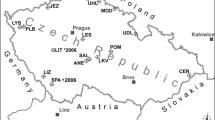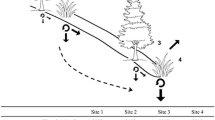ABSTRACT
Chemical changes along headwater streams at the Hubbard Brook Experimental Forest in New Hampshire suggest that important differences exist in biogeochemical cycles along an altitudinal gradient within small watershed ecosystems. Using data collected during the period 1982–92, we have constructed element budgets [Ca, Mg, K, Na, Si, Al, dissolved organic carbon (DOC), S, and N] for three subcatchments within watershed 6, a forested watershed last logged around 1917–20. The biogeochemistry of the high-elevation spruce-fir–white birch subcatchment was dominated by processes involving naturally occuring organic compounds. Stream water and soil solutions in this zone had elevated concentrations of organic acidity, DOC, and organically bound monomeric aluminum (Alo), relative to lower-elevation sites. The middle-elevation subcatchment, dominated by hardwood vegetation, had the greatest net production of inorganic-monomeric aluminum (Ali), and exhibited net immobilization of DOC and Alo. The low-elevation subcatchment, also characterized by deciduous vegetation, had the highest rates of net production of base cations (Ca2+, Mg2+, K+, Na+) among the subcatchments. Living biomass of trees declined slightly in the spruce-fir–white birch subcatchment during the study period, remained constant in the middle-elevation zone, and increased by 5% in the low-elevation subcatchment. Coupling the corresponding changes in biomass nutrient pools with the geochemical patterns, we observed up to 15-fold differences in the net production of Ca, Mg, K, Na, and Si in soils of the three subcatchments within this 13.2-ha watershed. Release of Ca, Na, and dissolved Si in the highest-elevation subcatchment could be explained by the congruent dissolution of 185 mol ha−1 y−1 of plagioclase feldspar. The rate of plagioclase weathering, based on the net output of Na, increased downslope to 189 and 435 mol ha−1 y−1 in the middle-elevation and low-elevation subcatchments, respectively. However, the dissolution of feldspar in the hardwood subcatchments could account for only 26%–37% of the observed net Ca output. The loss of Ca from soil exchange sites and organic matter is the most likely source of the unexplained net export. Furthermore, this depletion appears to be occurring most rapidly in the lower half of watershed 6. The small watersheds at the Hubbard Brook Experimental Forest occupy a soil catena in which soil depth and soil-water contact time increase downslope. By influencing hydrologic flowpaths and acid neutralization processes, these factors exert an important influence on biogeochemical fluxes within small watersheds, but their influence on forest vigor is less clear. Our results illustrate the sensitivity of watershed-level studies to spatial scale. However, it appears that much of the variation in element fluxes occurs in the first 10–20 ha of drainage area.
Similar content being viewed by others
Author information
Authors and Affiliations
Additional information
Received 13 August 1998; accepted 7 September 1999.
Rights and permissions
About this article
Cite this article
Johnson, C., Driscoll, C., Siccama, T. et al. Element Fluxes and Landscape Position in a Northern Hardwood Forest Watershed Ecosystem. Ecosystems 3, 159–184 (2000). https://doi.org/10.1007/s100210000017
Issue Date:
DOI: https://doi.org/10.1007/s100210000017




